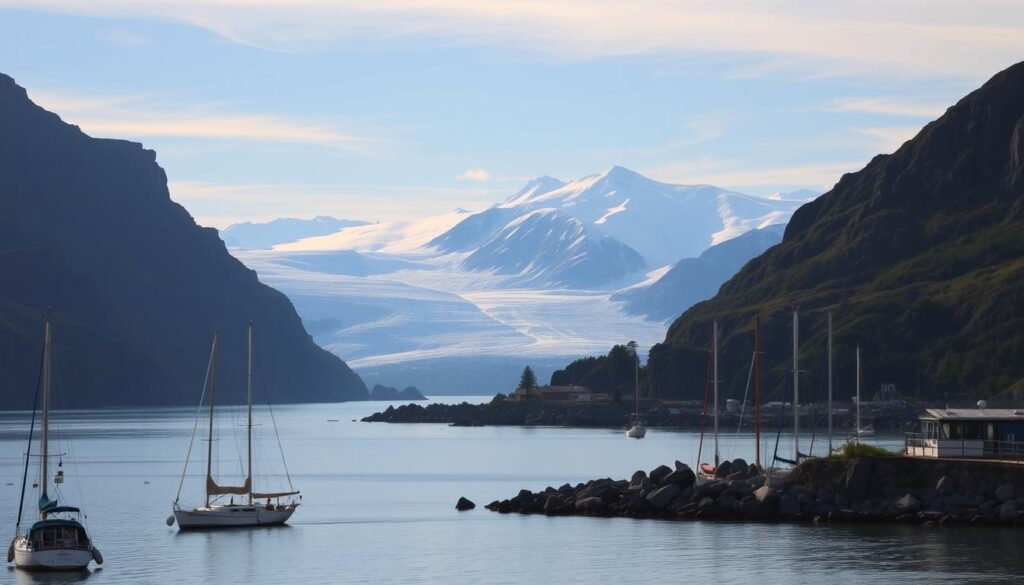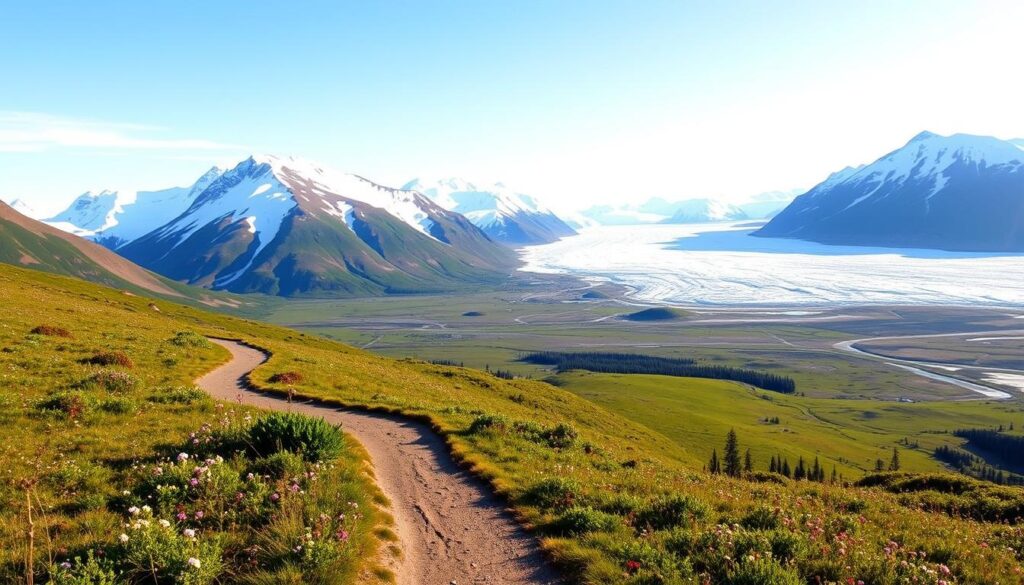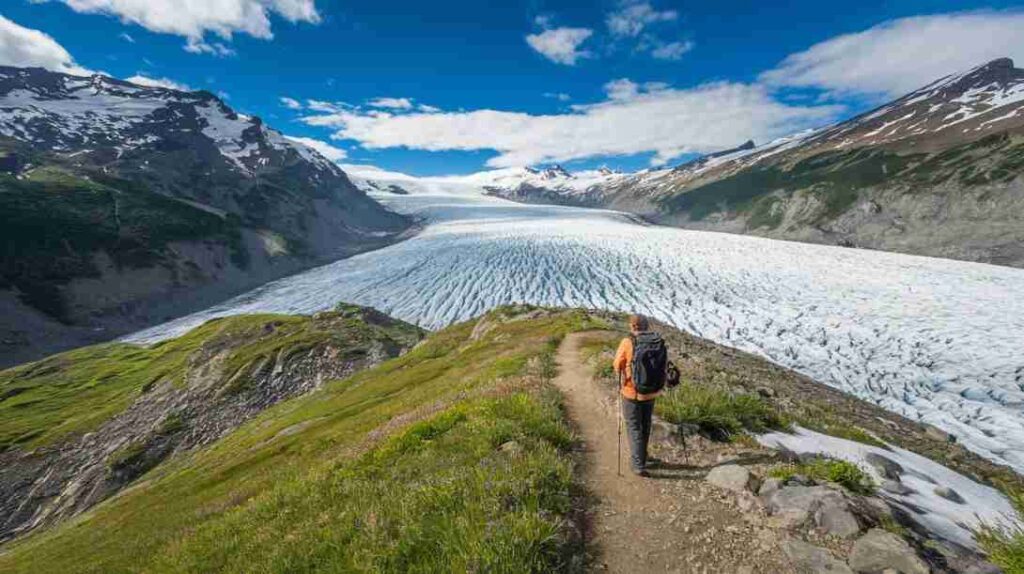Imagine standing on a rugged path, surrounded by towering peaks and vast expanses of ice. The Harding Icefield Trail offers just that—a breathtaking journey through one of Alaska’s most iconic landscapes. Located in the heart of Kenai Fjords National Park, this trail is a gateway to natural wonders that feel almost otherworldly.

The round trip is 8.2 miles and begins at the Exit Glacier Area. Hikers will encounter dense forests, rocky landscapes, and alpine meadows. There are unobstructed views of the icefield as well as encompassing mountain ranges which reveal parts of the Earth’s glacial history. Even better, this adventure is special because Kenai Fjords National Park happens to be one of the few national parks in the U.S that does not require an entry fee, making it accessible for everyone.
For people looking to visit, useful information like parking and shuttle services is provided for a better experience. This hike is more than just walking; it is an opportunity to spend time outdoors and appreciate the wild beauty of Alaska.
Key Takeaways
- The Harding Icefield Trail is an 8.2-mile round trip starting from the Exit Glacier Area.
- It offers stunning views of the icefield and surrounding peaks in Kenai Fjords National Park.
- Kenai Fjords National Park is one of the few U.S. national parks with free entry.
- Parking and shuttle services are available for convenience.
- The trail provides a unique opportunity to explore Alaska’s glacial landscapes.
Trail Overview and Basic Information
Treading upon this trail is like taking a gentle stroll through the molds of time and the ancient glaciers. This well known trail is more than a physical test; it is an expedition into the Alaskan wilderness. Each step immerses you deeper into the tale of the glaciers, mountains, and the beauty of the alps.
Understanding the Trail’s History and Significance
Walking this path is like a peaceful walk through the remains of the ancient glaciers. The path, which is widely known, is more than just a trek; it is a journey into the wild lands of Alaska. With every step, one is brought deeper into the story of the alps, glaciers, mountains, and alpine beauty.
“This trail is a window into the Earth’s glacial history, offering a glimpse of how ice shaped the land.”
Key Trail Statistics and Sections
A rewarding yet challenging hike is the 8.2-mile round trip which has an elevation gain of roughly 1,000 feet per mile. The hike is quite an endurance test. Nevertheless, even a brief hike offers stunning sights of the glacier and the valley underneath.
The trail is divided into distinct sections, each offering unique experiences:
- Marmot Meadows: A lush alpine area perfect for a quick rest.
- Top of the Cliffs: A rocky section with panoramic views of the glacier and surrounding peaks.
- Switchbacks: A challenging climb that rewards hikers with breathtaking vistas.
| Statistic | Details |
|---|---|
| Total Distance | 8.2 miles (round trip) |
| Elevation Gain | 1,000 feet per mile |
| Expected Time | 6-8 hours (full hike) |
| Key Sections | Marmot Meadows, Top of the Cliffs, Switchbacks |
This trail provides options for both casual explorers and experienced hikers. In Alaska, it’s a blend of history, challenge, and natural beauty which makes it an absolute must-see.
Location, Access, and Park Details
Your journey to Kenai Fjords National Park starts with planning. The park, which is next to Seward, Alaska, is reachable via car or shuttle. The trailhead is located at the Exit Glacier Area which usually opens in the middle of May, bestowing it the perfect location for summertime hikes.
How to Reach Kenai Fjords National Park and Exit Glacier
Finding the right directions to the park is easy. The Exit Glacier Nature center is a short drive from downtown Seward. If you do not have a car, shuttle services are available to take you to the trailhead. Parking at the Nature Center is plentiful, but arriving early guarantees a parking space, especially during busy times.

The ride leading to the Exit Glacier Area is quite beautiful, with the park clearly signposted. Regardless of the great views, always check for road conditions first as weather changes can impact travel. For safety reasons, it is recommended to hike in a group, and as with any challenging outdoor activity, having enough water is crucial because there are few refill points.
Entrance Fees, Shuttle Services, and Facility Information
Getting into Kenai Fjords National Park is completely free which is without a doubt its most exciting feature. As a result, any type of traveler can enjoy themselves. If you’re looking for convenience, shuttle services from Seward offer an inexpensive route to the trailhead.
At the Exit Glacier Nature Center, visitors can learn about the park through the available informational displays located in the restroom facilities. Remember to plan ahead because cell service in the region is scarce. To guarantee a hassle-free visit, bringing a physical map or downloading resources ahead of time will help.
Driving and taking the shuttle all deliver stunning views, ensuring that the trip to the park is an experience in itself. By applying the provided tips and doing some basic planning beforehand, your visit to Kenai Fjords National Park will be unforgettable.
How to Hike the Harding Icefield Trail
This hike will take you through a variety of landscapes and views. Whether you have years of experience or you are new to this, you need to prepare in advance to maximize what you can get from this trip. The trail’s steep climbs and sudden changes in weather will require you to be prepared, both physically and mentally.
Preparing for a Strenuous Adventure
This journey might be challenging for novices. Due to the rapid elevation gain and different changes, you must prepare in advance. You can begin improving your stamina with some cardio and leg workouts. This makes it easier to navigate the steep parts of the trail with assurance.
Always remember that weather can alter in a moment’s notice, so make sure you pack warm clothes. Even in summer, some areas may still have snow which will lead the boots you wear to need to have good traction on rocks and slippy areas. Be certain not to overlook basic items such as food, water, and even a first-aid kit.
“Preparation is the key to enjoying this challenging yet rewarding hike.”
Notable Turnaround Points and Scenic Overlooks
As previously stated, not everyone is seeking the endpoint, and that is perfectly normal. For those who prefer shorter hikes, there are picturesque places, such as Marmot Meadows, which is about a mile in and offers scenic alpine views and a nice place to rest. Later on, the Top of the Cliffs offers panoramic views of the glacier and other surrounding peaks.

The people motivated to reach the top may find the switchbacks that come to the end to be downright difficult. Every effort made on this hike is extravagantly compensated for, considering the incredible views one gets from the top as you are left breathless looking over the expansive icefield that stretches endlessly beneath you.
| Landmark | Distance from Start | Highlights |
|---|---|---|
| Marmot Meadows | 1 mile | Lush alpine area, perfect for a break |
| Top of the Cliffs | 3 miles | Panoramic views of the glacier |
| Terminus | 4.1 miles | Unmatched views of the icefield |
Regardless if you reach the end of the trail or choose to turn back before hitting the 5 miles mark, the views available on these hikes are breathtaking. Following the advice of others can help make this an unforgettable trip.
Best Time to Hike and What to Expect
Planning your hike at the right time can either enhance your experience or prove to be a daunting task. The perfect time to undertake this hike would be between July and early September, as this is when the weather is relatively stable and the nature trail is most open. Nonetheless, even during this time, hikers should expect swift changes in weather.
Seasonal Considerations for a Safe Journey
The warm weather during the summer coupled with low snow levels provides a great hiking experience. Starting late spring and early fall also provides opportunities, however, the danger increases during this time. Even more, residual snow and avalanches can create very dangerous conditions on the trail. For safety purposes, always check the trail reports prior to setting out.
Make sure to remember that there are clear differences in hours of daylight. July has nearly eighteen hours of clear daytime while September has close to twelve. Plan your hike in such a way that you finish before sunset to keep out of dark navigation.
Weather Conditions and Wildlife Safety Tips
It’s vital to wear layers since weather changes can occur without warning. Monitor the weather for the possibility of rain, wind, or snow at higher altitudes. A good jacket and reliable boots must be waterproof.
Bring bear spray withyou, as the region is home to black bears. To minimize potential run-ins with them, make some noise while hiking. For maximum safety, it is advisable to hike in groups. As always, prepare for an uncommon encounter with wildlife–and ensure and safe and smooth adventure.
| Season | Conditions | Tips |
|---|---|---|
| July-August | Warm, minimal snow | Bring layers, start early |
| Early September | Cooler, shorter days | Check daylight hours, carry bear spray |
| Shoulder Seasons | Snow, avalanche risk | Check trail reports, avoid risky areas |
By choosing the right time and preparing for the unexpected, you can make the most of this incredible hike. Whether you’re a seasoned adventurer or a first-time visitor, these tips will help ensure a safe and enjoyable experience.
Essential Gear and Preparation Tips
The proper equipment can turn a difficult hike into a rewarding one. Regardless if it’s summer or the shoulder seasons, making sure ahead of proper preparations ensures safety and enjoyment. Every single item from clothing layers to essential supplies packed in your backpack is important.
Must-Have Hiking Essentials and Clothing Layers
Start with the basics: sturdy footwear, warm clothing layers, and rain gear. Weather conditions can change quickly, so dressing in layers allows you to adapt. A waterproof jacket is a must, even in summer, as rain showers are common.
Don’t forget sun protection. A hat, sunglasses, and sunscreen are essential for long hours on the trail. Hiking poles can provide stability on steep or uneven terrain, reducing strain on your knees.
Hydration is key. Carry plenty of water and consider a filtration system for refills. Pack extra food to keep your energy levels up, especially on strenuous hikes. High-calorie snacks like nuts and energy bars are great options.
Additional Gear for Early/Late Season Hiking
Early and late season hikes require extra preparation. Snow and ice may still be present, so traction devices like microspikes are invaluable. Check trail conditions before heading out to ensure safety.
Layering becomes even more critical during these times. Thermal base layers, insulated jackets, and waterproof pants help combat cold and wet conditions. Gloves and a warm hat are also recommended.
Bear spray is a must-have for wildlife safety. Make noise while hiking to avoid surprising animals, and always travel in groups if possible. Being prepared for the unexpected ensures a smooth and enjoyable experience.
By packing smart and checking trail conditions, you’ll be ready for any adventure. The right gear not only enhances your hike but also keeps you safe from start to end.
Conclusion
Exploring this iconic path is a chance to witness nature’s grandeur up close. The journey rewards hikers with stunning views of the valley and beyond, offering a glimpse into Alaska’s wild beauty. From lush meadows to rugged peaks, every step is an adventure.
Preparation is key. Pack essentials like layers, water, and bear spray for safety. Volunteer efforts help maintain the trail, ensuring it remains accessible for future explorers. Respecting the environment ensures its preservation for generations to come.
Whether you’re a seasoned hiker or a first-time visitor, this experience is unforgettable. Plan your trip responsibly, and embrace the challenge. The rewards—panoramic vistas and a connection to nature—are worth every step.
FAQs
How long does it take to complete the hike?
Most hikers spend 6 to 8 hours round trip, depending on pace and stops. It’s a strenuous trek, so plan accordingly.
Is the trail suitable for beginners?
This hike is challenging and best for experienced hikers. The steep elevation gain and rugged terrain require good fitness and preparation.
Are there bears on the trail?
Yes, black bears are occasionally spotted. Carry bear spray, make noise, and stay alert, especially in less crowded areas.
What’s the best time of year to hike?
Mid-June to September is ideal. Snow often lingers into early summer, and conditions can be icy or muddy outside this window.
Do I need a permit to hike?
No permit is required, but it’s recommended to check with Kenai Fjords National Park for updates on trail conditions and closures.
What should I bring for the hike?
Essentials include sturdy boots, layers for changing weather, plenty of water, snacks, sunscreen, and a map. Trekking poles can also be helpful.
Are there restrooms along the trail?
Restrooms are available at the trailhead but not along the route. Plan accordingly and follow Leave No Trace principles.
Can I bring my dog on the hike?
Pets are not allowed on this trail to protect wildlife and preserve the natural environment.
Is there cell service on the trail?
Cell service is limited or nonexistent. Download maps and trail information beforehand and let someone know your plans.
What are the views like at the top?
The summit offers breathtaking panoramas of Exit Glacier, the vast icefield, and surrounding peaks. It’s a rewarding sight for the effort.
For more such stories, please visit stayvibes.com.

